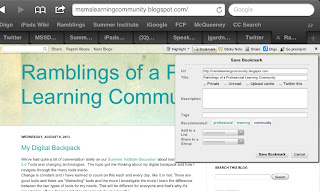Joining and participating in the Flat Classroom Teacher Certification Course is no exception to the above. The leaders, Julie Lindsay and Vicki Davis, are exceptional educators bar none. Their work in global collaboration over the years has brought more teachers and students together in a meaningful way that embodies what "flattening the classroom" signifies - kids working together from all parts of the world on relevant topics. But it goes beyond these two women. The cohorts in the group bring experiences and knowledge I've not encountered. They are smart, creative thinking people and I'm surrounding myself with them because I have so much to learn. And the book, Flattening Classrooms, Engaging Minds is well worth the read, everything you wanted to know about flattening the classroom and more.
This week I'm busy relearning Netvibes to serve as my RSS for the course and rethinking about what it means to connect with others and flatten the classroom. I'll work outward. The first step to flattening a classroom is to remove the barriers of the classroom walls and school walls so that the student classroom is a large community, interacting and collaborating with one another. Whether the communication is global or from within the same city need not matter at first. The idea is to cross the barriers and create communication and collaboration in learning where, before the flattening, there was none.
From there this larger community develops relationship and works toward common goals. I like the term Alan November uses - Digital Learning Farms. A flat classroom is similar. The flat classroom is the farm and everyone on the farm works toward the success of the farm. Everyone has a job to do and without one job being performed the overall goal isn't quite met. Everyone needs to come together, work hard, and see their work matters.
But it gets better than just my description. Yvonne Caples, one my cohorts in the group writes:
For me, ‘flattening the classroom’ and ‘flat learning’ are about utilizing technology to expand the audience, the connections, the activities, the outcomes and the learning landscapes to make learning more meaningful, efficient, collaborative, and representative of the flattened work environment that students will enter in their future. Read more.Wow! That's what I'm talking about by surrounding yourself with excellence. And Yvonne's comments echo the others'. It's really cool being part of an amazing group.





